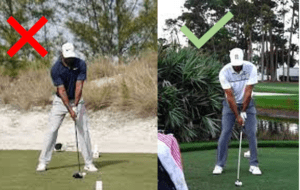Optimize Your Indoor Simulator Golf Practice for Peak Performance
While the crisp winter air beckons, New York City golfers don’t have to wait for spring to tee off on their game improvement journey. Indoor simulator facilities provide a powerful platform to maintain swing mechanics, refine technique, and even elevate overall golfing prowess during the off-season.
Maximize your indoor practice sessions and hit the ground running come spring with these pro tips from Collin, your trusted golf instructor:
1. Establish SMART Goals: Before hitting the virtual greens, set Specific, Measurable, Achievable, Relevant, and Time-bound (SMART) goals. Are you aiming to enhance accuracy by 5%, increase average driving distance by 10 yards, or refine short game consistency? Clearly defined goals allow for targeted practice and effective progress tracking.
2. Leverage Simulator Capabilities: Most simulators offer a diverse range of practice modes and drills designed to address specific golfing aspects. Explore these features to target individual weaknesses, whether it’s bolstering wedge distance consistency, mastering diverse shot types, or focusing on getting better at playing Par 3’s or Par 5’s. Simulate diverse course scenarios: Incorporate various distances, elevations, and wind conditions to prepare yourself for the challenges you might encounter on a real course. This enhances your adaptability and overall golfing prowess.
3. Beyond Beating Balls: Move Past the Myth of Repetition: While hitting balls mindlessly can provide a temporary sense of satisfaction, it often yields limited lasting improvement. Indoor simulators offer a unique opportunity to transcend repetitive practice and embrace strategic training methods. Utilize a combination of block and random practice.
- Block practice: Focus on isolating and refining specific swing mechanics through targeted drills and exercises. Pay close attention to elements like posture, grip, and swing sequence.
- Random practice: Introduce variability by simulating diverse course scenarios, incorporating various distances, elevations, and wind conditions. This enhances adaptability and mental preparation for real-world challenges. Most simulators allow you to practice on holes – hit a wide variety of different shots on the same hole to better recreate the randomness you may face while actually on the course.
4. Analyze Your Swing Visually: While simulators provide feedback on ball flight, remember that bad data can be worse than no data. Be cautious of getting overly reliant on the numbers displayed, as they may not always accurately reflect how the ball might fly outside. Instead, focus on analyzing your swing visually. Pay close attention to key elements like:
- Release pattern: How the club releases through impact, affecting ball flight and spin.
- Low point of the swing: The clubhead’s position at its lowest point, impacting ball trajectory and distance.
- Wrist angles: The position of your wrists throughout the swing, influencing clubface angle and swing path.
- Swing plane: The imaginary path the clubhead travels during the swing, affecting accuracy and consistency.
- Contact point on the clubface: The precise location where the ball strikes the clubface, determining ball flight and spin.
- Body movement: How your torso and hips turn, how you use the ground and pressure shifts just to name a few.
Recording your swing on video is the most powerful tool these simulators offer. Capture multiple swings from different angles and compare them to identify areas for improvement. Seek guidance from Collin for deeper analysis and personalized recommendations based on your visual swing assessment.
One note of caution is to always record your swing from the same angles.
Down the Line (DTL) at hand level: Often people film from down the ball line but with launch monitor technology I find it best to focus down the hand line
Face-On at hand level:
*Notice they are both looking at the hands but the angles are very different
Maintaining consistency in your recording setup allows for accurate comparisons and avoids misinterpretations based on camera perspective.
5. Elevate Your Game with Personalized Instruction: While indoor simulators offer valuable practice opportunities, consider seeking personalized instruction from Collin to truly expedite your golfing transformation. Collin, a passionate and experienced golf instructor, offers customized lessons and coaching programs tailored to your individual needs and goals. Whether you’re a beginner looking to build strong fundamentals or a seasoned player aiming to refine your technique, Collin can help you reach your full potential.
By following these tips and incorporating personalized instruction from Collin, you can leverage your indoor simulator sessions to optimize your swing mechanics, refine your technique, and elevate your overall golfing performance. Remember, consistent practice, even during the off-season, is key to maintaining your skills and achieving your golfing aspirations throughout the year. So, embrace the challenge, step into the virtual greens, and emerge from winter a more confident and well-rounded golfer, ready to conquer the course come spring. Book a lesson HERE


